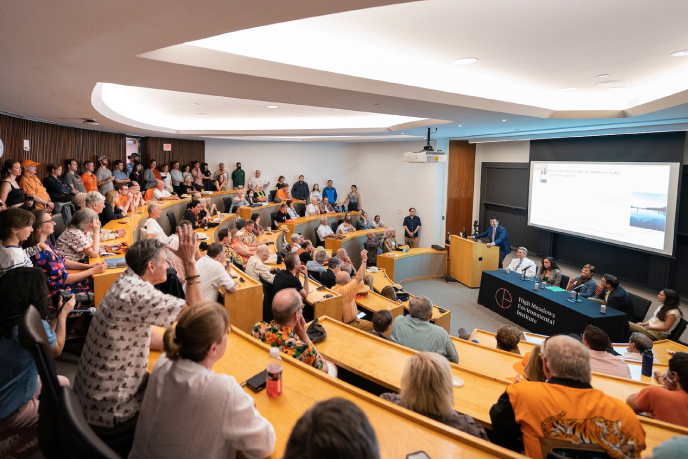A Half Century of Data Reveals a Complex Web of Human Impacts on New England Forests


Using a unique half century of data, scientists have determined that a combination of anthropogenic climate change, nitrogen pollution, two severe storms, and heavy logging interacted in a complex way to impact the inner workings of contemporary forests in north eastern United States. This tangled web of influences has obscured the natural baseline from which researchers seek to measure how these forests are responding solely to climate change.
A group led by Lars Hedin, professor of ecology and evolutionary biology and faculty member at the Princeton Environmental Institute (PEI), and Susana Bernal, a former Fulbright postdoctoral research associate in Hedin’s laboratory, used the longest record of watershed nutrient and climate dynamics existing anywhere in the world, representing a half century of meticulous monitoring, to understand how climate and nitrogen pollution interact to traumatize these forests.
Hedin initially became interested in this research when he discovered that nitrogen levels in temperate forest watersheds had unexpectedly and inexplicitly dropped over the past half century. Although nitrogen is a nutrient for plant growth, at high concentrations it is a dangerous pollutant that affects drinking water and surface waters such as streams and rivers.
Initially Hedin and his colleagues thought that climate change alone might be responsible for the drop in the forest’s nitrogen levels, but they found the drop resulted from a much more complex web of interactions involving a combination of severe weather events that occurred in 1938 and 1998, changes in climate, nitrogen pollution from agricultural fertilizers and air pollution, and historic logging practices which decimated much of the forest at the turn of the twentieth century. Hedin and colleagues published their findings in the February 13, 2012 issue of the Proceedings of the National Academy of Sciences (PNAS).
“How present day stresses interact with events from long ago is one of the greatest challenges we face in understanding the complexity of ecosystems today,” said Hedin. “Our findings show that even with a half-century record of data, one of the most complete and rare data sets in the world, it is still difficult for us to answer the critical question of what constitutes the baseline against which climate change and other human impacts should be measured,” said Hedin.
The United States government has made a significant legislative effort to decrease nitrogen concentrations in forests and watersheds. Nitrogen pollution and climate change pose long term threats to the health of these forests. “Our findings address critical issues that scientists and policy-makers must understand in order to better protect and preserve temperate forests,” Hedin said.
The research was led by Hedin, Susana Bernal, Hedin’s former postdoctoral research associate and now at the Center for Advanced Studies of Blanes in Girona, Spain, and Gene E. Likens of the Cary Institute of Ecosystem Studies in Millbrook, NY. Researchers also included Don C. Buso, also of the Cary Institute, and Stefan Gerber, Hedin’s former postdoctoral research associate, now assistant professor at the University of Florida. The laboratory of Daniel Sigman, professor of geosciences and a PEI associated faculty member, assisted with isotope analysis.
To conduct this research, Hedin and his colleagues examined factors relating to nitrogen pollution (such as concentrations of atmospheric nitrogen and dissolved nitrogen in the watershed) and how these interact with the impact of climate change on the forest (such as accelerated tree and plant growth), soil temperatures, and microbial denitrification) and how these in turn have an effect on soil hydrology. Hedin concluded that changes in climate have altered the paths of water flow in the forest watersheds, resulting in a longer growing season and higher soil temperatures which has in turn resulted in lower levels of nitrogen.
In addition, Hedin and his colleagues evaluated whether the recent increase in sugar maple mortality throughout these northeastern forests could explain any of the changes in nitrogen levels in the water, but they did not find a connection. Hedin determined that climate change could account for a large part of the nitrogen decline but, surprisingly, that a secondary contributing factor was the history of disturbances to the forest by extreme weather events and logging.
Using models to study the impact of heavy logging in these forests in 1906 and 1917, and the destruction caused by two severe storms, the 1938 hurricane and the 1998 ice storm, Hedin found that the models confirmed his hypothesis by showing that forests are sensitive to historical disturbances and that these interact with changes in climate to determine present day forest conditions. In contrast to the effects of anthropogenic climate change alone, Hedin’s research showed that 60% or more of the long term changes in nitrogen decline can be explained by the damage that the tree harvesting and the extreme weather events of 1938 and 1998 are still having on the forest.
“We thought impacts from changes in climate alone would make these forests grow more quickly, and thus explain the nitrogen trend. But to our surprise we found no evidence that forests grew faster, nor that this would explain the nitrogen trend. What we anticipated would be a simple and straightforward interaction between climate and nitrogen turns out to be unexpectedly complex, due to the tree loss from logging and the storms,” said Hedin.
To view the paper, please go to www.pnas.org/content/early/2012/02/10/1121448109.full.pdf+html .
This study was supported by the Cooperative Institute for Climate Science, National Oceanic and Atmospheric Administration and the A.W. Mellon Foundation.
Relating article: Why Human Activity Can Make Discerning the Impacts of Climate Change So Difficult, Time.



